“Global AI in Virtual Reality Market to reach a market value of 217.6 Billion by 2031 growing at a CAGR of 42.2%”
The Global AI in Virtual Reality Market size is expected to reach $217.6 billion by 2031, rising at a market growth of 42.2% CAGR during the forecast period.
HMDs are extensively used in various applications such as gaming, training, simulations, and virtual tours. The immersive nature of HMDs, which cover the user's field of view and provide high-quality visuals, makes them the preferred choice for a fully engaging virtual reality experience. This growing adoption across different industries underscores the importance of HMDs in the VR ecosystem. Thus, the head-mounted displays (HMDs) segment recorded 28% revenue share in the AI in virtual reality market in 2023. This segment's significant share is attributed to the widespread adoption of HMDs, which is crucial for providing immersive VR experience.
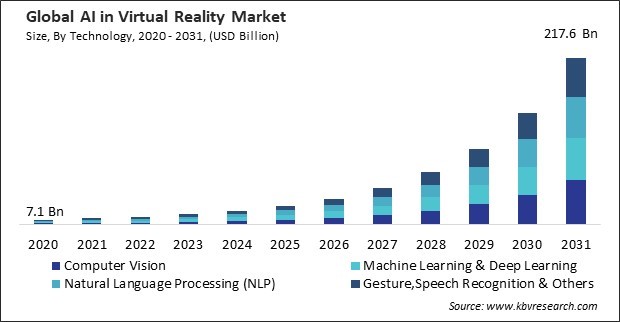
The major strategies followed by the market participants are Product Launches as the key developmental strategy to keep pace with the changing demands of end users. For instance, In September, 2024, Meta Platforms, Inc. unveiled updates to its virtual reality headset and Ray-Ban smart glasses, showcasing advancements in AI and next-gen computing. The AR glasses are designed to be lightweight, wireless, and under 100 grams. A wristband interface, called Orion, allows users to control devices through brain signals, enhancing interaction beyond voice and gestures. Additionally, In January, 2024, Qualcomm Incorporated unveiled the Snapdragon XR2+ Gen 2 platform, which enhances XR and VR experiences with improved GPU and CPU performance—15% and 20% faster, respectively. It supports 12+ cameras and on-device AI for seamless tracking, enables 4.3K resolution, and delivers clearer visuals for immersive productivity and entertainment in mixed reality.
Based on the Analysis presented in the KBV Cardinal matrix; Apple, Inc., Google LLC and Microsoft Corporation are the forerunners in the AI in Virtual Reality Market. Companies such as Meta Platforms, Inc., Samsung Electronics Co., Ltd., and Qualcomm Incorporated are some of the key innovators in AI in Virtual Reality Market. In June, 2023, Apple, Inc. announced the launch of Apple Vision Pro, a spatial computer that smoothly integrates digital content with the physical world. The Vision Pro makes a three-dimensional user interface that can be controlled by eyes, hands, and voice. It features a vision spatial operating system to deliver a seamless interaction experience.
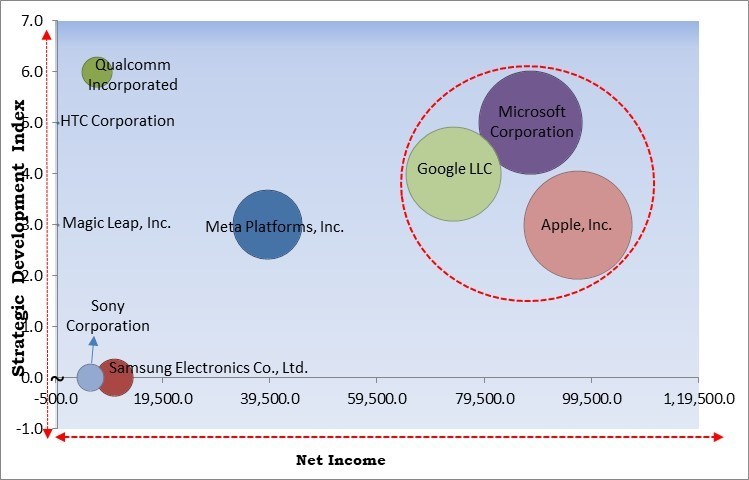
The demand for enhanced user experience (UX) in virtual reality (VR) is a major factor driving the growth of AI in VR technologies. Gaming, healthcare, and education increasingly seek immersive, interactive environments to engage users more effectively. With AI, VR systems can offer highly personalized experiences, adjusting to the user’s real-time preferences, actions, and learning needs.
Additionally, AI plays a crucial role in these immersive VR experiences by enabling intelligent behavior in virtual environments, such as responsive non-playable characters (NPCs), dynamic storylines, and real-time interactions that adapt to the player’s actions. Thus, increased demand for immersive experiences in the gaming industry is propelling the market's growth.
The high cost of developing and implementing AI-powered VR solutions remains a significant barrier for many businesses. Developing VR applications that integrate AI requires substantial investment in hardware and software, including specialized equipment such as high-end VR headsets and servers capable of running complex AI algorithms. Therefore, high development and implementation costs are hindering the growth of the market.
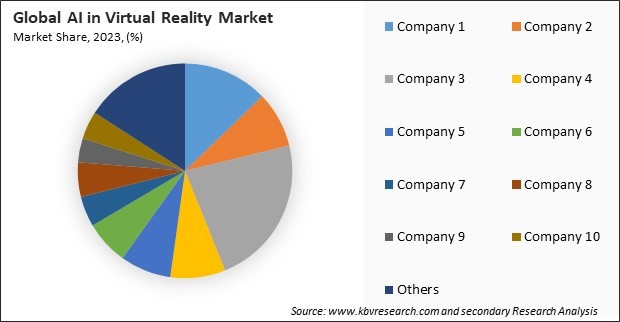
The leading players in the market are competing with diverse innovative offerings to remain competitive in the market. The above illustration shows the percentage of revenue shared by some of the leading companies in the market. The leading players of the market are adopting various strategies in order to cater demand coming from the different industries. The key developmental strategies in the market are Product Launches and Product Expansions.
Based on technology, the market is divided into computer vision, machine learning & deep learning, natural language processing (NLP), gesture, speech recognition, and others. The machine learning & deep learning segment held 24% revenue share in the market in 2023. These technologies are vital for advancing virtual reality applications, improving interaction dynamics, and enabling more natural user interactions.
On the basis of platform, the market is segmented into head-mounted displays (HMDs), desktop computers & consoles, mobile devices, projectors & smart glasses, and wearables & body tracking devices. The mobile devices segment held a 20% revenue share in the market in 2023. Mobile devices offer a more accessible and portable option for VR experiences, contributing to their growing popularity. Mobile devices have become increasingly compatible with VR applications, making VR technology more widely available.
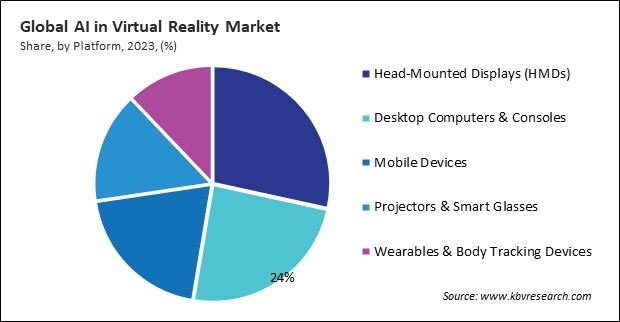
By application, the market is divided into gaming & entertainment, education & training, healthcare & medical, retail & e-commerce, social media & communication, industrial & manufacturing, tourism & travel, and others. The healthcare and medical segment attained a 14% revenue share in the market in 2023. AI in VR is revolutionizing healthcare by providing advanced solutions for medical training, surgical simulations, and patient treatment plans.
Free Valuable Insights: Global AI in Virtual Reality Market size to reach USD 217.6 Billion by 2031
Region-wise, the market is analyzed across North America, Europe, Asia Pacific, and LAMEA. In 2023, the Europe region generated 30% revenue share in the market. Europe's substantial share is driven by the growing adoption of VR technology across diverse sectors, including automotive, manufacturing, and tourism. Countries like Germany, France, and the UK are leading the charge with significant investments in VR applications for training, design, and simulation.
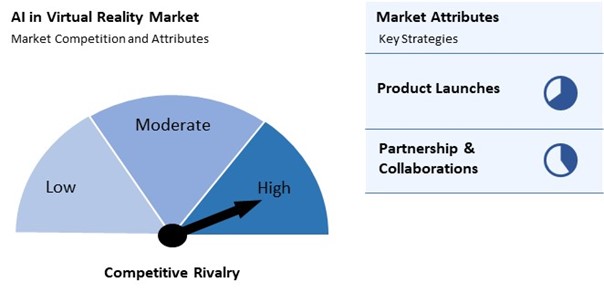
The AI in Virtual Reality (VR) market is highly competitive, driven by advancements in machine learning and immersive technologies. Key attributes include real-time data processing, adaptive environments, and personalized user experiences. Competition centers on delivering cutting-edge solutions for industries like gaming, healthcare, and training. Players focus on improving AI's ability to simulate human-like interactions and optimize virtual environments. The market also emphasizes scalability, accuracy, and seamless integration, as companies strive to differentiate through innovation and enhanced user engagement.
| Report Attribute | Details |
|---|---|
| Market size value in 2023 | USD 13.9 Billion |
| Market size forecast in 2031 | USD 217.6 Billion |
| Base Year | 2023 |
| Historical Period | 2020 to 2022 |
| Forecast Period | 2024 to 2031 |
| Revenue Growth Rate | CAGR of 42.2% from 2024 to 2031 |
| Number of Pages | 320 |
| Tables | 432 |
| Report coverage | Market Trends, Revenue Estimation and Forecast, Segmentation Analysis, Regional and Country Breakdown, Competitive Landscape, Market Share Analysis, Porter’s 5 Forces Analysis, Company Profiling, Companies Strategic Developments, SWOT Analysis, Winning Imperatives |
| Segments covered | Technology, Platform, Application, Region |
| Country scope |
|
| Companies Included | Microsoft Corporation, HTC Corporation, Meta Platforms, Inc., Samsung Electronics Co., Ltd. (Samsung Group), Sony Corporation, Unity Software Inc., Magic Leap, Inc., Apple, Inc., Qualcomm Incorporated (Qualcomm Technologies, Inc.) and Google LLC |
By Technology
By Platform
By Application
By Geography
This Market size is expected to reach $217.6 billion by 2031.
Rising demand for enhanced user experience in virtual reality are driving the Market in coming years, however, High development and implementation costs restraints the growth of the Market.
Microsoft Corporation, HTC Corporation, Meta Platforms, Inc., Samsung Electronics Co., Ltd. (Samsung Group), Sony Corporation, Unity Software Inc., Magic Leap, Inc., Apple, Inc., Qualcomm Incorporated (Qualcomm Technologies, Inc.) and Google LLC
The expected CAGR of this Market is 42.2% from 2024 to 2031.
The Computer Vision segment is leading Market by Technology in 2023; thereby, achieving a market value of $58.2 billion by 2031.
The North America region dominated the Market by Region in 2023, and would continue to be a dominant market till 2031; thereby, achieving a market value of $78.2 billion by 2031.
Our team of dedicated experts can provide you with attractive expansion opportunities for your business.

 Drivers
Drivers
 Restraints
Restraints
 Opportunities
Opportunities
 Challenges
Challenges
